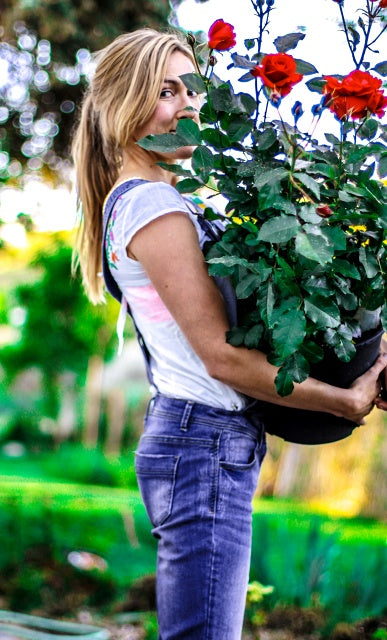by Ken Lain, the mountain gardener

The fragrance will remind you of visits to Grandmother’s house. A truly outstanding rose for the large flowers and captivating fragrance, and super easy to grow. She is in a class by herself, even in the hottest of sun locations. In fact, the more sun she receives, the more flowers you will have.

Roses are deciduous shrubs that bloom in the late spring. The outstanding quality of many rose varieties is the sweet fragrances of their flowers. The blooms appear in the mid-to-late spring in branching clusters. The leaves are green to blue in color and grow 2” inches long. In autumn, they change to an aspen gold color. The best time to plant rose bushes is in the early spring, just after the ground thaws. They have a moderate growth rate of 1 to 2 feet per year.
Botanical Name Rosa
Common Name Rose
Plant Type Deciduous shrub
Mature Size 4′ feet x 4′ feet
Sun Exposure 6+ hours full sun
Soil Type Well-drained soil
Soil pH 6 to 8
Bloom Time Spring and mid-summer through fall
Flower Color Lavender, pink, purple, orange, blue, white and more
Hardiness Zones 3-8
How to Grow Roses
Common rose bushes are so special they are often treated as specimen plants, grown as focal points in the landscape. They can also be planted in rows along property borders and pruned into loose hedges. The ‘Easy Elegance’ and Knockout varieties are small enough for use in foundation plantings.
Soil
All roses prefer soil that is rich in organic matter. The soil can be neutral to slightly alkaline. Good drainage is essential; Roses do poorly in soggy, wet soil.
1.Dig hole 2-3 times the width of the container but the same depth.
2. Score the root ball sides and bottom with a utility knife or pruners and place them in the planting hole.
3. Blend Watters Premium Mulch into the native soil at 1 part mulch with two parts soil dug from the hole and pack firmly around the roots.
4. Sprinkle 7-4-4 All Purpose Plant Food around the planting area.
5. Prevent ‘Transplant Shock’ by adding Watters “Root & Grow” to your water at 2-week cycles for the first 2 months.
6. Use the remaining Watters Mulch inside the tree well as a top dressing. This will keep weeds down, insulate roots from heat and cold, and keep the roots moist.
Light
Roses tolerates mountain wind, even on the highest ridge lines. Roses bloom best with 6+ hours of sun; the more, the better. It can tolerate partial shade, but it comes at the cost of reduced bloom.
Water newly planted roses regularly with a garden hose for at least one month (2 months in Summer). Automatic irrigation systems may not be sufficient initially. Water frequency will vary according to season, exposure and plant size.
April – Oct roses should be irrigated 2 x weekly
Nov – Mar roses should be irrigated 2 x monthly
Feed 4x Times per Year with 7-4-4 All Purpose Plant Food, Soil Sulfur, or Humic. Here’s the recommendation by season:
March = 7-4-4 All Purpose Food + Soil Sulfur
June = 7-4-4 All Purpose Food + Humic
September = 7-4-4 All Purpose Food
December = 7-4-4 All Purpose Food
Temperature & Humidity
Like most roses, they need an extended period of cold winter, making it perfect for cold mountain landscapes. In areas with hot (100+ degree) summers, roses blooms longer in locations that provide some shelter from the strong afternoon sun. Summer monsoon rains encourage this shrub to rebloom.
The shrub is not affected by humidity unless the weather is sweltering and humid, which will slow down the reblooming.
Pruning
Pruning is critical for roses, promoting flowering and ensuring air circulation to prevent powdery mildew and other issues. The right time to prune is early spring, March, just as the foliage emerges. Prune branches to thin growth for better air circulation. This also keeps the shrub’s height at the desired level. Cut off the dead flowers when they are done blooming. This prevents seed from forming and promote more profuse flowers.
Common Pests/Diseases
Rose buds are sweet and enjoyed by deer and javelina. Knockout roses are more resistant to powdery mildew and leaf spots than hybrid tea and floribunda cousins. Because powdery mildew, a fungus, thrives in humid weather, ensure good air circulation in and around your roses by giving it enough space.
Aphids and thrip are the most common bugs causing leaves to curl and bugs to appear dried and scorched. Watters ‘Triple Action’ spray easily controls Mildew and insect issues. Ask for help at the first sign of any issue.

Free Garden Classes offered by Watters Garden Center
We go deep into growing better. Check out this spring’s class selection offered every Saturday @ 9:30 am.
March 25 – Proper Planting in Mountain Soils
April 1 – Growing Better Peonies this Spring
April 7 – Lilacs and Better Fragrant Gardens
Until next week, I’ll be helping gardeners’ plant fragrant roses here at Watters Garden Center.
Ken Lain can be found throughout the week at Watters Garden Center, 1815 Iron Springs Rd in Prescott, or contacted through his website at WattersGardenCenter.com or Top10Roses.com.

